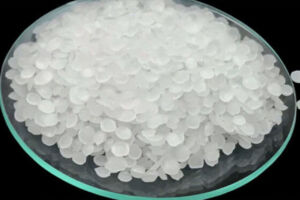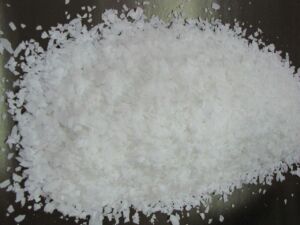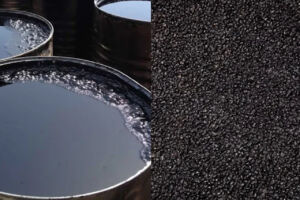Jet fuel is a type of aircraft fuel that is used for airplanes with turbine engines, such as turbojet, turbofan, turboprop, and turboshaft helicopters.
Turbine engines are generally capable of using a variety of petroleum fuels, but all types of jet fuel today are types of kerosene. which has high purity and additives have been added to them to prevent corrosion, rusting, freezing at low temperature or ignition at high temperature.
A suitable jet fuel should have a high ignition temperature, should not precipitate or cause rust, should have a high calorific value, and should be safe to transport and work with. It does not damage the hot parts of the engine turbine and flows well in cold weather.
Jet fuel is a middle distillate or by-product of refined crude oil that falls between the two groups of lighter and heavier crude oils. As the name suggests, it is mainly used to power jet engines. Jet fuel demand growth is expected to accelerate over the next decade as the number of passengers increases more than ever before. We mainly deal in A-1 jet fuel, which we source directly from refineries across the Middle East and North Africa region. Our quality product is delivered on time.
Jet fuels for civil aircraft are divided into three general categories:
Jet fuel A and A1: Jet fuel A is the standard jet fuel in the United States. And in other parts of the world, the A1 standard is used. The ignition point of both of them should be higher than 38 degrees Celsius and their auto-ignition temperature should be higher than 210 degrees.
B jet fuel: This type of fuel is a combination of about 30% kerosene and 70% gasoline. This type of fuel has a lower freezing temperature and does not freeze up to 60 degrees below zero. Its ignition point is also lower and as a result it is considered a more dangerous fuel. This type of fuel has better performance in cold weather and is used only in very cold weather.
Plane fuel
The materials that are used as airplane fuel are different from the fuel that is used by other vehicles that need fuel in the world, even cars and cars, and they have very high sensitivities. Any way you think about it, the fuel used for airplanes varies in terms of volume, concentration, composition of materials and many other elements. According to experts, airplane fuel is directly used due to its high concentration and lack of sulfur and low acidity after adding the required additives.
Due to the development of the aviation industry, this fuel was not what everyone expected and thus provided a basis for the creation of other aviation fuels. JP-3 fuel was produced in 1947 and consists of 65-70% gasoline and 30-35% oil, and it causes the problem of engine misfires to be solved in the cold, and it also has improved engine starting altitudes. But this fuel tends to vaporize, which causes the engines to shut down.
With the launch of new plans to increase aircraft fuel production in Imam Khomeini, Shazand, Shahid Tandgoyan (Tehran), Abadan, Lawan and Kermanshah oil refineries, the countdown to Iran’s entry into the club of exporters of this strategic product with the launch of new plans to increase fuel production. Aircraft in the oil refineries of Imam Khomeini, Shazand, Shahid Tandgoyan (Tehran), Abadan, Lawan and Kermanshah, the countdown for Iran’s entry into the club of exporters of this strategic oil product has begun.
Aircraft fuel production
With the beginning of the production of aircraft fuel with Euro 4 and 5 standards of the European Union in domestic refineries. Construction of airplane fuel pipelines has started from Tehran and Imam Khomeini oil refineries in Shazand to some major airports in the country such as Imam Khomeini and Mehrabad airports in Tehran.
The fuel produced and supplied in air refueling centers inside the drawer is fully in accordance with international standards and approved by IATA.
By exploiting the second phase of the third phase of the Abadan Oil Refinery Development and Renovation Plan, after Iran’s presence among the countries that export jet fuel and passenger planes, the possibility of self-sufficiency in the supply of helicopter gasoline and all kinds of educational and agricultural planes has been provided.
Iran is one of the largest producers of gasoline for all types of passenger planes
In the current situation, Iran is one of the largest producers of gasoline for all types of passenger planes, cargo and jet fuel. With the exploitation of the third phase of the Abadan Oil Refinery Development Plan, it is possible to produce gasoline for all types of helicopters and some small educational and agricultural planes. So that the production of “helicopter” gasoline is one of the by-products of this oil project. Currently, in addition to the supply of ATK, 4JP fuel for military and law enforcement airplanes and helicopters, 100 LL gasoline for piston airplanes (internal combustion) and VH airplane fuel are also produced and supplied in the country.
Currently, due to having fuel supply capacities, high fuel production capacity with IATA standard at the level of oil refineries, and privileged geographical position as a bridge connecting East and West Asia with Europe, the Caucasus region, Central Asia with the Persian Gulf and Africa is one of the most important hubs for fuel supply and distribution to international airlines.
Currently, more than 100 domestic and foreign airlines supply their gasoline from Iran’s aviation refueling centers.
According to the statistics of the National Petroleum Refining and Distribution Company, currently the amount of fuel supplied to airplanes in Tehran (including the flights of airplanes at Imam Khomeini Airport (RA) and Payam Airport) is 2 and in the whole country is 4.
In addition, to the supply of ATK, 4JP fuel for military and law enforcement airplanes and helicopters, 1LL gasoline for piston airplanes (internal combustion) and VH airplane fuel are also produced and supplied domestically.






